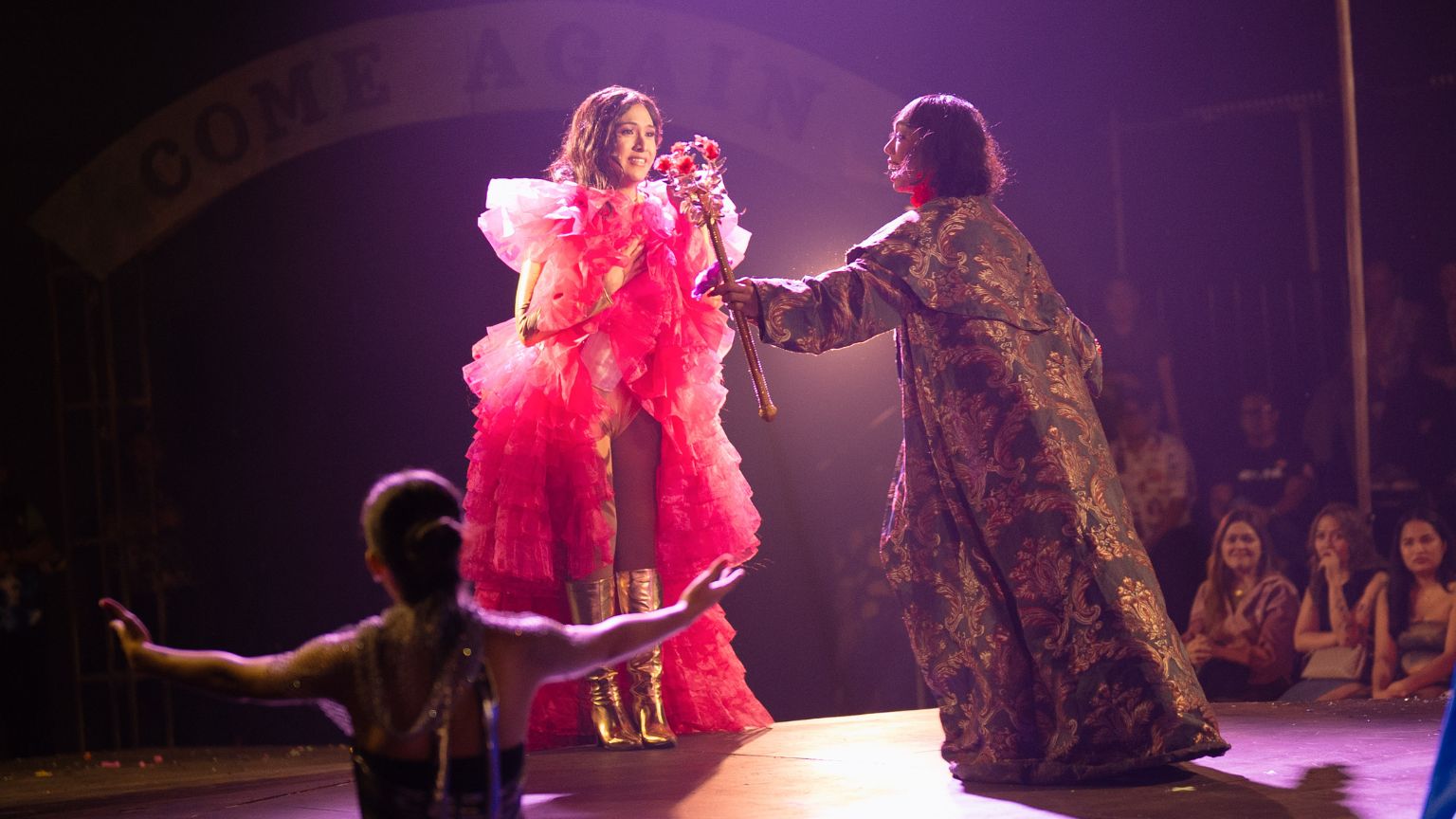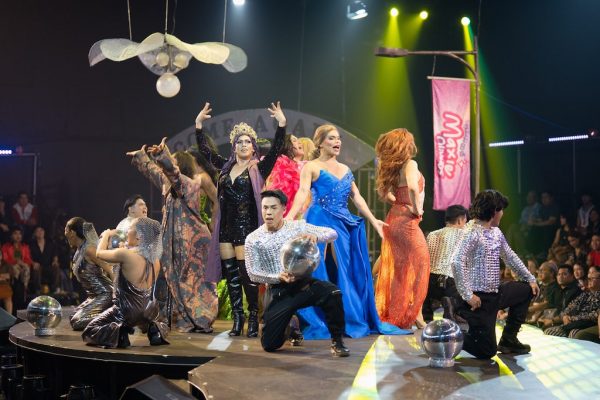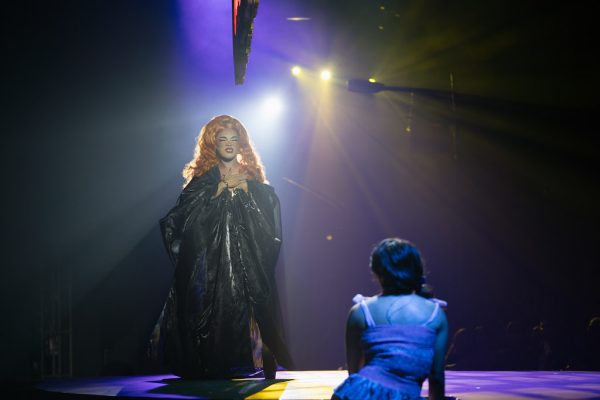
REVIEW: In ‘Dalaga na si Maxie,’ drag is chosen family
There’s a twofold ambition at the heart of Dalaga na Si Maxie. On one hand, it sets out to continue the story of Maxie, the beloved queer character first introduced in Ang Pagdadalaga ni Maximo Oliveros. On the other, it strives to showcase drag not only as performance but as life-giving art—a medium of expression, healing, and family. It only patchily succeeds at the former, but it does quite well in achieving the latter. What lingers most from this 80-minute musical is the reminder of how life-changing it can be for someone to find their people.
Set in 2018 during the height of the Duterte administration’s war on drugs, Dalaga na Si Maxie follows Maxie, now a young transwoman grappling with PTSD after witnessing her father’s killing at the hands of the police. Over the course of the show, Maxie finds herself drawn into the vibrant, sometimes chaotic, but ultimately healing world of drag. As she turns 18, she finds a sense of belonging—and a new kind of family—among a group of drag performers who take her in and help her debut as a full-fledged queen.
Directed by Melvin Lee, written by Julia Enriquez and Mica Santos, and performed in a thrust-style black box theater that brings the audience close to the action, Dalaga na Si Maxie blends musical theater and drag performance. The result is a show that’s brisk, lively, and overflowing with heart—but also one that sometimes feels like it’s rushing past its most potent material.
The show flows smoothly, thanks to Lee’s energetic yet grounded direction and a stage design (by Charles Yee) that facilitates clean transitions: a long platform with entrances on both ends and a circular platform centerstage where much of the action takes place. The pacing feels tight, almost too tight. At just 80 minutes, it is packed with drag and musical numbers that dazzle—but leave little room for the actual plot to breathe.
There’s no lack of narrative material here. Maxie’s circumstances, the internal dynamics among her new drag family, Mama Tars’ (solid performance from Jem Manicad) unjust arrest under Duterte-era drug war policies—these are meaty topics that the show introduces but never unpacks. Even Maxie’s own trauma arc—her fear of loud sounds, her PTSD, her healing—is quickly resolved in a way that feels emotionally convenient. She overcomes her fear seemingly through sheer will, which comes across more as a tidy narrative shortcut than a fully developed transformation. Similarly, Mama Tars’ release from police custody happens without clarity: Did her drag family buy her freedom? Did the justice system actually function?
Though the book could benefit from deeper exploration, the performances bring sincerity and charm. Jamila Rivera as Maxie is a radiant, fresh-faced presence—wide-eyed and full of wonder as she steps into the drag world. While the role doesn’t allow her to show much range, Rivera’s earnestness and strong vocals help ground Maxie’s journey.

The cast of Dalaga na Si Maxie Oliveros: A Drag Musical Extravaganza; Photo Credit: J+ Productions
The drag family Maxie joins—played by real-life drag artists including Zymba Ding as Katana G, Gabriel Villaruel as Lili Lorena, Winter Sheason Nicole as Aqua Sweet/Mary Grace, MRS TAN as Kriska B/Rainbow Bright, Corazon as Elsa Balutan/Klang Klang, and Gerhard Krystoppher as Pretzels—bring their own brand of charisma, uniqueness, nerve, and talent. Though their characters aren’t deeply fleshed out, their relationships with Maxie feel distinct. You wish there were more time to explore their backstories: Why is one of them initially cold to Maxie? Why does Mama Tars take her in so quickly? Given a full-length runtime, these queens would likely rise to the occasion.
Still, the show smartly leans into the strengths of its cast. Rather than expecting drag artists to conform to musical theater conventions, the production leans into the drag. The result feels authentic and respectful—a homage to drag as lived experience, not just aesthetic. It helps that the musical performances are diverse, blending live singing, interpretive movement, and lip sync numbers curated to reflect real drag repertoires.
The musical direction by JJ Pimpinio is serviceable, with a mix of local and international pop songs. While the song choices don’t always feel intentional in a narrative sense (it’s not a jukebox musical, but it isn’t a book musical either), they’re delivered with flair. One standout moment features Villaruel lip syncing to Pink’s “What About Us”—a powerful allegory for trans rights. Rivera’s Maxie watches the number from the sidelines, her silent awe echoing the feeling of being seen for the first time. It’s a subtle but moving tableau.

L-R: MRS TAN (Kriska B/Rainbow Bright), Jamila Rivera (Maxie); Photo Credit: J+ Productions
Choreography by Gio Gahol adds purpose to the numbers, especially in sequences like “What About Us,” where movement underscores emotional resonance. Costume design by Tata Tuviera is stunning, with Maxie’s visual transformation from ‘baby gay’ to fully fledged queen offering strong payoff. Lighting by David Esguerra and set design by Yee support the runway-like staging, but the projections (designed by Jana Jimenez) feel like an afterthought—especially since they’re relegated to side walls and are central to communicating Maxie’s backstory, often via footage from the original film.
What is perhaps most moving are moments where Maxie sits quietly, absorbing the drag around her like someone finally seeing a future for herself. The show doesn’t challenge views on drag, queerness, or trauma, but it affirms something vital: that drag is more than art. It’s kinship, survival–home.
Dalaga na Si Maxie may not fully succeed as a political or narrative deep-dive, but it shines in its portrayal of drag as a communal, human, and necessary act of queer expression. Whether you’re part of the community or not, its core message is universal: we all need somewhere to belong.
Tickets: Php 2500
Show Dates: June 16 – 22, 2025
Venue: Illumination Studio, Makati City
Running Time: approx. 1 hour and 20 mins (no intermission)
Company: J+ Productions
Creatives: Melvin Lee (director), Mean Espinosa (assistant director), Julia Enriquez (playwright/dramaturg), Mica Santos (playwright/dramaturg), J-mee Katanyag (script consultant), JJ Pimpinio (musical director and arranger), Gio Gahol (choreographer), Charles Yee (set designer), Tata Tuviera (costume designer), Jana Jimenez (video projection designer), David Esguerra (lights designer), Loren Rivera (technical director), Happy Constantino (sound designer), Arvy Dimaculangan (sound designer), Ghie Bernardo (sound engineer)
Cast: Jamila Rivera, Zymba Ding, Gabriel Villaruel, Winter Sheason Nicole, MRS TAN, Corazon, Gerhard Krystoppher, Jem Manicad, Gerhard Krystoppher, Ado Villanueva, Air Paz, Gerald Magallanes, Honey Bravo, Jay Cortez, Marit Samson, Misha Fabian, Robert Macaraeg


Comments